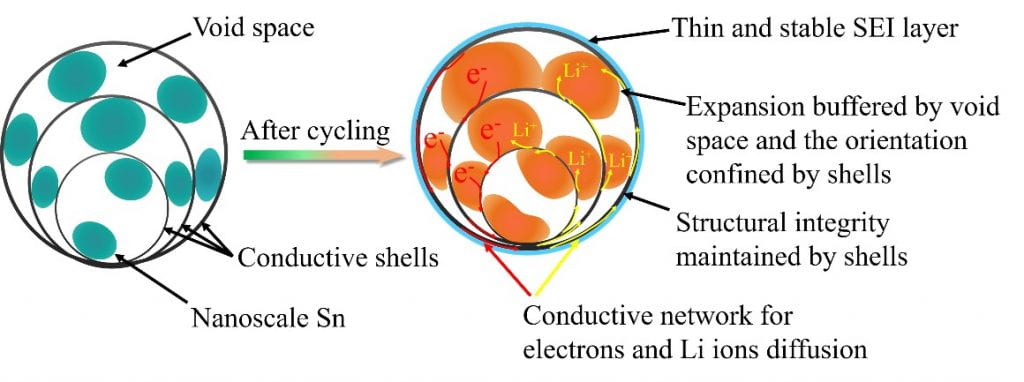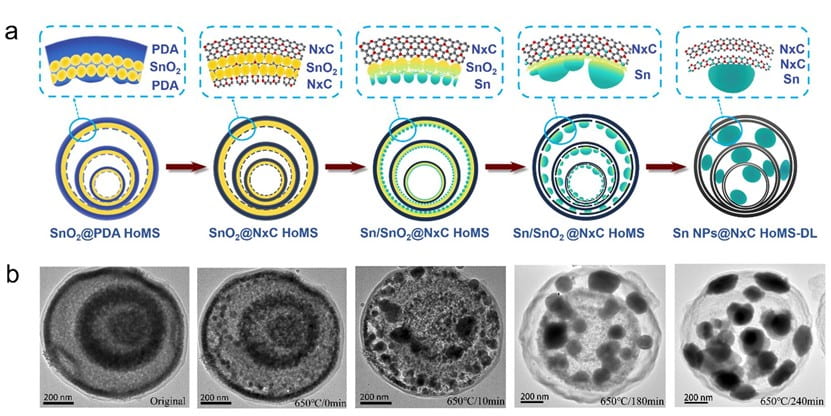Photo: Professor Wei Gao and Dr Bo Li
“Advanced Materials” May 2022
Accurately Localizing Multiple Nanoparticles in a Multishelled Matrix Through Shell-to-Core Evolution for Maximizing Energy-Storage Capability
A battery anode material research article from Professor Wei Gao’s group has been published in “Advanced Materials.”
To accelerate the adoption of electric and plug-in hybrid vehicles, electrode materials with a high capacity are highly desired. However, high-capacity electrode materials such as Sn, Si, usually suffer from huge volume expansion during lithiation process, which would cause structural fracture and induce a poor cycling life. To address the above problems, great efforts have been devoted to the material design, mainly including minimizing the size to nanoscale and constructing composites by coating with carbon, metal or oxide. Despite the impressive achievements, the cycling life and/ or rate capability still fail to satisfy the practical requirements. More delicate structures remain to be designed and developed.
Here, Professor Wei Gao’s group with their cooperators proposed an ideal structure to effectively solve the problems by accurately localizing multiple electrode-material nanoparticles separately in the different sites of a nitrogen-doped carbon hollow multishelled structure (NxC HoMS) (Scheme 1). Such a structure could well buffer the stress/strain by enabling cores to expand without collisions, achieve a good electron and ion conductivity through a three-dimensional conductive network constructed by multiple conductive shells connecting with multiple cores, and stabilize the solid electrolyte interphase (SEI) (Scheme 1), thus significantly improving the energy storage performance.

Scheme 1. Localizing high-capacity electrode nanoparticles separately in the conductive HoMS matrix, enables a fast mass diffusion and good cycling stability (note: SEI means solid electrolyte interphase).
Despite the excellent electrochemical properties, such elaborate structure has been rarely reported due to the highly challenging fabrication. In this work, they develop an innovative and facile synthesis strategy of “in situ evolution of shell to core”, to localize multiple Sn nanoparticles (NPs) separately in one NxC HoMS, surprisingly, with duplicated layers (DL) obtained for NxC shell (Sn NPs@NxC HoMS-DL) (Figure 1). As expected, such a structure enables Sn anode to realize its theoretical lithium storage capability, the as-prepared Sn NPs@NxC 3s-DL (Sn NPs localized in NxC triple-shelled structure with DL) maintains a high specific capacity of 961 mAh g-1 that’s 96% of the theoretical capacity, after 2000 cycles at a current rate of 2C (1C = 1000 mA g−1). (Figure 2) Through this elaborate structure, the bottlenecks of other high-capacity electrode materials including Si, Li anodes and S cathode could also be addressed.

Figure 1. the in-situ shell-to core-evolution stratery

Figure 2. the cycling performance of the synthesized electrodes.
The research has been published in the journal Advanced Materials (IF 30.8, DOI: 10.1002/adma.202200206). The first author is Dr Bo Li from Professor Wei Gao’s group.

Photo: CHEMMAT Masters student (2021) Carolina Coronado Triviño
“Energy News” 12 September 2022
A new paper on geothermal potential of co-produced hot water from existing oil production wells in Colombia at the Geothermal Workshop from Professor Brent Young’s group has been in Energy News.
The paper was presented at the workshop by our PhD student Isaac Severinsen. Isaac received an award for the best paper in session 5.3 Production and Management!
Carolina Coronado Triviño was a Masters of Energy student under Dr Wei Yu’s and Professor Brent Young’s supervision last year.
About the paper:
Techno-economic estimation of the geothermal potential of existing Colombian oilfield production wells
Coronado Triviño C1, Yu W2, Severinsen I*2, Van Campen B1 and Young B2
1Department of Engineering Science, University of Auckland, Auckland, New Zealand
2Department of Chemical and Materials Engineering, University of Auckland, Auckland, New Zealand
Keywords: Organic Rankine Cycle, Low temperature utilization, Co-produced fluid.
Abstract
Using co-produced hot water from oil and gas wells and binary power plant technology for power generation purposes has been piloted in oilfields worldwide with profitable results. In Colombia these geothermal resources associated with oilfields are available with geothermal gradients up to 65°C/km. Oil and gas producers have expressed interest in technologies that enable decarbonization of oilfield operations. With this in mind, the development of this type of project could be economically and environmentally beneficial.
This work analyses data from oil and gas wells in Colombian oilfields to evaluate the feasibility of implementing a binary plant using the available co-produced water. The numerical calculations included economic and thermodynamic analysis of Organic Rankine Cycle (ORC) specifications for different working fluids and geothermal fluid supply temperatures. It was determined that n-pentane is the most appropriate working fluid at the conditions of 90°C brine supply temperature and 27°C ambient temperature. This finding is supported by industrial realities, but it is notable that it is not impacted by high ambient temperatures. Economic analysis showed a levelised cost of energy of 55 USD/MWh with a 7-year payback time.
This work supports proposed geothermal development in Colombia. Small scale, low risk, profitable projects like this can catalyse the industry and spur development.